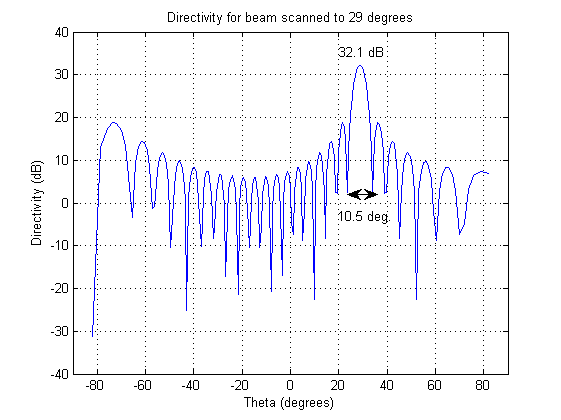Daily Image
29-01-2014What does the presence of grating lobes do to your effective area - part I
| Submitter: | Michel Arts & Stefan Wijnholds |
| Description: | The application of sparse regular arrays raises the question whether the presence of grating lobes reduces the effective area of the array in the scan direction. We have investigated this problem by considering the array in transmit situation as this allows for a more intuitive explanation. It does not matter for the results, since the array pattern is the same in transmit and in receive situation due to the reciprocity theorem. This theorem means that if in transmit situation the antenna radiates a lot of power in a certain direction, the effective area in that direction is large if you use the same antenna in receive situation. The picture on the left shows the radiation pattern of 20x20 uniform rectangular array with isotropic elements if it is scanned 29 degrees from zenith. The gain of the array found to be 32.1 dB. The width of the main beam is found to be 10.5 degrees. The picture on right shows what happens if the array is scanned 43 degrees from zenith. The grating lobe at -60 degrees is clearly visible. The gain of the main lobe has decreased to 27.9 dB. The beam width has increased to 12.6 degrees. Normally, the gain of an antenna is roughly inversely proportional to the main beam width. If the main beam width increases from 10.5 to 12.6 degrees one expects a decrease in gain by a factor of 1.2 (17%). However, the gain decreases with 4.2 dB, corresponding to a factor 2.6, in this example. This result can be explained very intuitively by considering that in the transmit situation, the total amount of energy distributed over the sky following the array beam pattern is the same in the two cases discussed here. Since the energy is distributed over two lobes when the grating lobe is present (the main lobe and the grating lobe), this results in less energy for each direction and hence in a lower gain. The latter is proportional to the effective area of the array. This means that if the array is considered in receive situation, the effective area also drops with a factor of 2.6 if the scan angle is increased from 29 to 43 degrees. Next time, we will show a picture where the effect of decreasing effective area due to the presence of grating lobes is investigated further. |
| Copyright: | ASTRON |
| Tweet |  |
